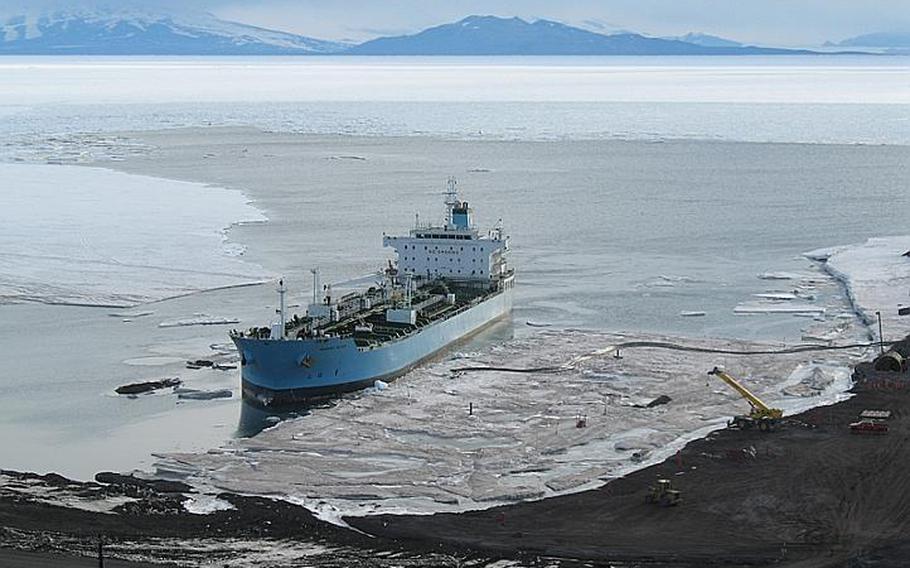Asia-Pacific
US uses Russian icebreaker to get fuel supplies to Antarctica
Stars and Stripes February 12, 2012

The Russian icebreaker Vladimir Ignatyuk cut a channel through Antarctic sea ice late last month so that a Military Sealift Command tanker could deliver millions of gallons of fuel to McMurdo Station. (Courtesy of National Science Foundation)
McMURDO STATION, Antarctica — The U.S. is relying on a Russian icebreaker to deliver supplies to its main base in Antarctica thanks to continued problems with its own shrinking fleet of the cold-water vessels.
Late last month, the Russian icebreaker Vladimir Ignatyuk cut a channel through Antarctic sea ice so that a Military Sealift Command tanker — the Maersk Peary — could deliver millions of gallons of fuel to McMurdo Station. A second MSC ship, the Green Wave, also is bound for McMurdo and will need the Russian icebreaker’s help to deliver supplies and equipment that will sustain the station through the harsh Antarctic winter.
The job of cutting supply channels through the ice has traditionally fallen to the U.S. Navy and Coast Guard. However, the military’s inaction on updating its fleet has led to an increased reliance on foreign vessels.
The U.S. has only one operational icebreaker, the Coast Guard Cutter Healy, which has been busy escorting a Russian-flagged tanker through the iced-over waters in the Bering Sea to supply Nome, Alaska.
The Coast Guard owns two other icebreakers, but the Polar Sea is being decommissioned, and the Polar Star is being refitted at a cost of $62.8 million, according to Lt. Eric Quigley, a capabilities manager with the Coast Guard.
The shortage of U.S. icebreakers, which cost $1 billion each to build, contrasts with a large Russian fleet that comprises more than two dozen of the massive ships, including several nuclear-powered vessels.
Russian icebreakers are in high demand to escort commercial shipping along the Northern Sea Route that follows Russia’s northern coast through Arctic waters between the Pacific and Atlantic oceans, according to Cmdr. Steve Wittrock, a Coast Guard budget officer.
The route is open for only two months each year, and moving sea ice means ships risk being trapped. However, the route is far shorter than traditional sea lanes connecting Europe and Asia, he said.
The potential need for more U.S. icebreakers was signaled in a Government Accountability Office report last month. The report warned that the Defense Department lacks a clear strategy for ensuring it will have the resources to operate in the Arctic, which is gaining strategic importance as melting ice opens new shipping possibilities and potential access to untapped natural resources.
While the DOD has begun to assess the capabilities needed to better operate in the Arctic’s harsh environment, the report said, it needs to better prepare to meet the challenges of navigating in the Arctic, where the U.S., Russia and other nations are competing for control of potentially valuable resources.
“Uncertainty involving the rate of Arctic climate change necessitates careful planning to ensure efficient use of resources in developing Arctic needs such as basing infrastructure and icebreakers, which require long lead times to develop and are expensive to build and maintain,” the GAO stated in its report.
Warming temperatures in the Arctic mean there will likely be more fishing, oil exploration and tourism there in the future that would likely require a greater Coast Guard presence, Wittrock said.
“There is an expansion in the level of maritime activity in the Arctic with generally decreasing ice coverage,” Wittrock said. “We are working with partners to understand what we might need beyond those two polar icebreakers.”
Extreme weather in the Arctic and a lack of infrastructure mean icebreakers are a good way to get Coast Guard resources into the region, he said.
Lt. Benjamin Morgan, who works in the Coast Guard’s mobility ice operations division, said icebreakers can also support science missions, enforce U.S. sovereignty in its territorial waters, perform search and rescue and enforce laws.
“Their icebreaking capabilities make them ideal to conduct these missions at high latitudes,” he said.